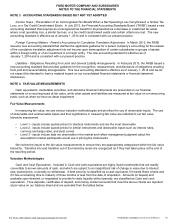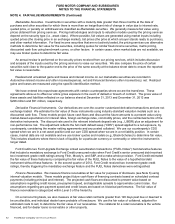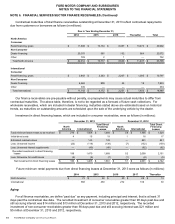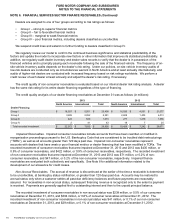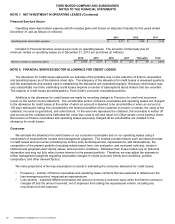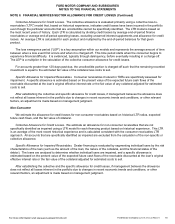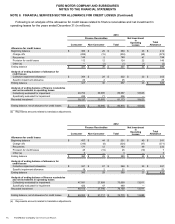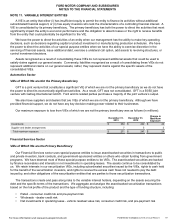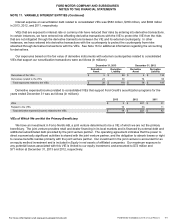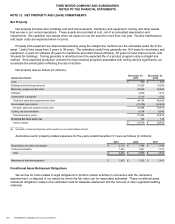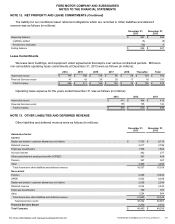Ford 2013 Annual Report Download - page 93
Download and view the complete annual report
Please find page 93 of the 2013 Ford annual report below. You can navigate through the pages in the report by either clicking on the pages listed below, or by using the keyword search tool below to find specific information within the annual report.
Ford Motor Company | 2013 Annual Report 91
FORD MOTOR COMPANY AND SUBSIDIARIES
NOTES TO THE FINANCIAL STATEMENTS
NOTE 6. FINANCIAL SERVICES SECTOR FINANCE RECEIVABLES (Continued)
Troubled Debt Restructurings. A restructuring of debt constitutes a TDR if we grant a concession to a borrower for
economic or legal reasons related to the debtor’s financial difficulties that we otherwise would not consider. Consumer
and non-consumer receivables that have a modified interest rate below market rate or that were modified in
reorganization proceedings pursuant to the U.S. Bankruptcy Code, except non-consumer receivables that are current with
minimal risk of loss, are considered to be TDRs. We do not grant concessions on the principal balance of our receivables.
If a receivable is modified in a reorganization proceeding, all payment requirements of the reorganization plan need to be
met before remaining balances are forgiven. The outstanding recorded investment at time of modification for consumer
receivables that are considered to be TDRs was $233 million, or 0.5% of consumer receivables and $249 million, or 0.5%
of consumer receivables during the years ended December 31, 2013 and 2012, respectively. The annual subsequent
default rate of TDRs that were previously modified in TDRs within the last twelve months and resulted in repossession for
consumer receivable was 5.8% and 5.8% of TDRs at December 31, 2013 and 2012, respectively. There were no non-
consumer receivables involved in TDRs during the year ended December 31, 2013 and the outstanding recorded
investment of non-consumer receivables involved in TDRs was de minimis during the year ended December 31, 2012.
Finance receivables involved in TDRs are specifically assessed for impairment. An impairment charge is recorded as
part of the provision to the allowance for credit losses for the amount that the recorded investment of the receivable
exceeds its estimated fair value. Estimated fair value is based on either the present value of the expected future cash
flows of the receivable discounted at the contract’s original effective interest rate, or, for receivables where foreclosure is
probable, the fair value of the collateral adjusted for estimated costs to sell. The allowance for credit losses related to all
active consumer TDRs was $23 million and $19 million at December 31, 2013 and 2012, respectively. The allowance for
credit losses related to all active non-consumer TDRs was de minimis at December 31, 2013 and 2012.
NOTE 7. NET INVESTMENT IN OPERATING LEASES
Net investment in operating leases on our balance sheet consists primarily of lease contracts for vehicles with
retail customers, daily rental companies, government entities, and fleet customers. Assets subject to operating leases
are depreciated using the straight-line method over the term of the lease to reduce the asset to its estimated residual
value. Estimated residual values are based on assumptions for used vehicle prices at lease termination and the
number of vehicles that are expected to be returned.
The net investment in operating leases was as follows (in millions):
December 31,
2013
December 31,
2012
Automotive Sector
Vehicles, net of depreciation $ 1,384 $ 1,415
Financial Services Sector
Vehicles and other equipment, at cost (a) 21,738 16,258
Accumulated depreciation (3,115)(2,347)
Allowance for credit losses (23)(23)
Total Financial Services sector 18,600 13,888
Total Company $ 19,984 $ 15,303
__________
(a) Includes Ford Credit’s operating lease assets of $8.1 billion and $6.3 billion at December 31, 2013 and 2012, respectively, for which the related
cash flows have been used to secure certain lease securitization transactions. Cash flows associated with the net investment in operating
leases are available only for payment of the debt or other obligations issued or arising in the securitization transactions; they are not available
to pay other obligations or the claims of other creditors.
For more information visit www.annualreport.ford.com


